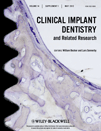Patient Satisfaction with Maxillary 3-Implant Overdentures Using Different Attachment Systems Opposing Mandibular 2-Implant Overdentures
ABSTRACT
Background: Patient-based outcomes with maxillary overdentures on a minimum number of implants, opposing mandibular 2-implant overdentures are not evident in the literature.
Purpose: To evaluate patient's satisfaction with maxillary 3-implant overdentures, opposing mandibular 2-implant overdentures, using two different attachment systems over the first 2 years of service.
Materials and Methods: Forty participants wearing mandibular 2-implant overdentures for 3 years were randomly allocated to one of two similar implant system groups to receive maxillary 3-implant overdentures. Twenty participants were allocated to splinted and unsplinted attachment system treatment groups for each system. Patient satisfaction with pre-treatment complete maxillary dentures, with maxillary 3-implant overdentures at baseline and annually for 2 years, was measured using visual analogue scale questionnaires and the oral health impact profiles. Palatal coverage of the maxillary overdentures was reduced at the first annual recall.
Results: Data showed significant improvement in pain reduction, comfort, stability, and function variables of the visual analogue scale after treatment. Analysis by prosthodontic design using visual analogue scale showed no significant difference. The total oral health impact profile-14 scores after treatment for all participants, regardless of prosthodontic design, were significantly lower (more satisfied). The overall oral health impact profile-20E score at baseline was significantly higher (more satisfied) compared with pre-treatment conventional maxillary dentures. No significant changes were observed in the first or second years compared with baseline results. Twenty-two participants (84.6%) preferred reduced palatal coverage, regardless of prosthodontic design, after 1 year. Twenty participants (76.9%) still preferred reduced palatal coverage at the end of the second year.
Conclusions: The provision of maxillary 3-implant overdentures to oppose mandibular 2-implant overdentures significantly improve levels of patient satisfaction compared with conventional maxillary dentures.




